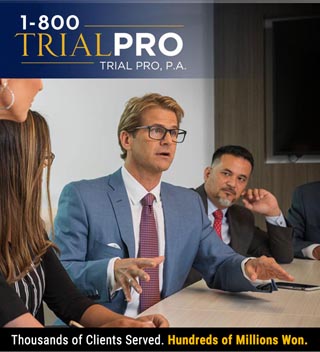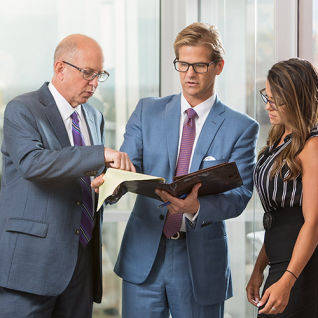Frequently Asked Questions - What Happens at a Deposition?

When you met with your attorney, he mentioned that he wants to take the deposition of the other driver in the automobile accident in which you were injured. Or you met with your attorney and he told you that the attorney for the other driver’s insurance company wants to take your deposition. Since you have never attended a deposition, one question is paramount in your mind – what happens at a deposition?
A deposition is a procedure whereby the attorneys representing parties to a lawsuit have an opportunity to question a person out of court but under oath. The person testifying in the deposition is referred to as the deponent. The deponent may be a party to the lawsuit, a fact witness to some aspect of the lawsuit, or an expert witness.
A deposition is typically attended only by the deponent, the attorneys for all parties, and a court reporter. However, a party has the right to attend the deposition. If the party is a juridical entity, as might be the case where the party is an insurance company or business, the party can be represented at the deposition by a live person, such as a corporate officer, manager or claims adjuster.
The deposition is usually held in a conference room at the law office of an attorney for one of the parties or in a conference room at a court reporter’s office. Typically, the deposition is held at the law office of the attorney who is producing the deponent, but that is not always the case. When it is not practical for all parties to meet at the same location, as might be the case when an attorney or witness is located in a different city, the deposition can be conducted by telephone.
The deposition begins with the court reporter administering an oath to the deponent. By this process, the deponent is obligated to testify truthfully and any false testimony is subject to the penalties of perjury. The attorneys may then dictate a stipulation on the record or simply tell the court reporter that the deposition is subject to the “usual stipulations.” Typically, this means that all objections except objections as to the form of the question or the responsiveness of the answer are deferred until such time as the transcript of the deposition is used in court. The deponent’s attorney may also reserve “reading and signing.” A deponent has the right to read the written transcript of his deposition and to submit a written list of corrections before signing the deposition transcript.
Once the court reporter has made a note of the stipulations, the questioning begins. The attorney who requested the deposition begins asking questions of the deponent. The court reporter’s job is to make a written record of all that is said and done during the deposition, in much the same manner that a court reporter makes a record of what is said and done in a courtroom. An attorney questioning the deponent may show the deponent a document and ask the deponent questions relating to the document. An attorney may ask the deponent to draw a sketch to better explain the deponent’s answer. When the first attorney is finished questioning the deponent, attorneys representing the other parties in the lawsuit have an opportunity to question the deponent. As a rule, the attorney who produced the deponent is given an opportunity to question the deponent after all of the other attorneys have questioned the deponent. Once all of the attorneys have questioned the deponent or passed on their opportunity to question the deponent, the first attorney (and possibly other attorneys in a case involving three or more parties) are given an opportunity to ask the second round of questions of the deponent. However, these questions are limited to the areas of questions raised by the other attorneys.
Nowadays, most jurisdictions limit the length of time that a person may be deposed without special approval from the trial judge. Typically, the duration is set at a day (i.e., seven to eight hours). However, some jurisdictions limit depositions to three hours without the prior approval of the trial judge. Because it is common for a deposition to last several hours, a deponent is permitted to ask for a recess or lunch break. Ordinarily, such a request will be accommodated, although the deponent is usually required to answer any question pending before the break is taken.
Sometimes, the attorneys will ask to “go off the record.” Where all of the attorneys agree to go off the record, this serves as a direction to the court reporter to stop recording what is said or done until he or she is instructed to go back on the record. The attorneys may ask to go off the record to straighten out a technical issue that may have arisen or to work through a non-controversial fact issue. Since court reporters typically charge for their services on a per page of transcript basis, the attorneys will often cooperate on non-controversial issues as a means of lessening the deposition costs. However, while an official record of what is said or done “off the record” is not made, the deponent should always remember that the attorneys can certainly hear and see what is done during the time that they are off the record. An attorney can and often does question a deponent over something that was said or done while they were off the record.
Although the attorneys may have entered into a stipulation regarding objections at the outset of the deposition, an attorney may still assert an objection to a question posed to the deponent. This is because the stipulation only covered objections other than objections to the form of the question or the responsiveness of the answer. Objections as to the form of the question and the responsiveness of the answer must still be asserted. The most common objections as to the form of the question are that the question is ambiguous, that the question is argumentative, that the question has been asked and answered, or that the question is a compound question (e.g., the question posed to the deponent is actually two or more questions).
When an objection is asserted on the record, the deponent should immediately stop answering the question until the attorneys have made their objections and responses to objections. When told to do so by his attorney, the deponent should proceed to answer the question.
Where the deposition runs through the normal lunch hour, it is generally advisable to take a break for lunch. Deponents oftentimes want to push through without a lunch break, particularly if the opposing attorney says he can wrap up his questioning in under an hour. The danger of continuing without a lunch break is that the deponent will become fatigued and with fatigue comes mistakes. It should also be noted that attorneys are notorious for misjudging the length of their witness examinations. Thus, an estimate of less than an hour can easily extend into an hour or more, particularly if the questioning touches on a sensitive area that the deponent is reluctant to address.
Some attorneys prefer to take video depositions. In the case of a video deposition, there is a videographer present in addition to the court reporter. The videographer’s job is to make a sound and audio recording of the deposition, while the court reporter is charged with preparing the written transcript and managing the documents that are used in or created in the deposition. During a video deposition, the camera is trained exclusively on the deponent. Consequently, in addition to the deponent’s answers, the camera will record the deponent’s physical appearance and all of the deponent’s mannerisms and body language.
At some point, the questioning will end and the attorneys will inform the court reporter that the deposition is over. They will confirm their arrangements with the court reporter for ordering copies of the deposition, gather any documents marked as exhibits during the deposition, and make arrangements for the deponent to read and sign his deposition. A shrewd attorney will oftentimes engage in small talk with the deponent while these activities are taking place. This is an application of the adage that one can catch more flies with honey than with vinegar. A well-schooled deponent should avoid engaging in small talk with opposing counsel, as nothing good can come of such conversation.
After the deposition is concluded, the court reporter will prepare a written transcript of the deposition. If the witness was shown any documents during the deposition, or if the witness was asked to draw a sketch during the deposition, the documents and/or sketch will be attached as exhibits to the deposition transcript.
Unless the deponent or his attorney has waived the right to read and sign the deposition, the deponent has the right to review the written transcript of his or her deposition. This is an important function. While court reporters are trained to record verbatim all that is said, they have been known to make mistakes. For example, the court reporter may have misheard the deponent’s answer or, in the court reporter’s haste to record an answer, he may have inadvertently left out a word or two. Where the court reporter has inadvertently left out the word “not,” the meaning of the answer can be very different. Thus, the opportunity for the deponent to read and sign the deposition is the deponent’s opportunity to correct any mistakes that the deponent may notice in the transcript. In most jurisdictions, there is a deadline by which a deponent may submit corrections. The deponent should ascertain this deadline from his attorney and adhere to it.





































